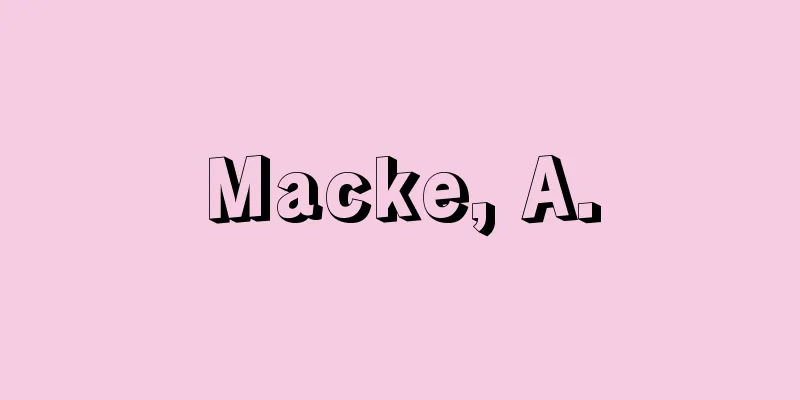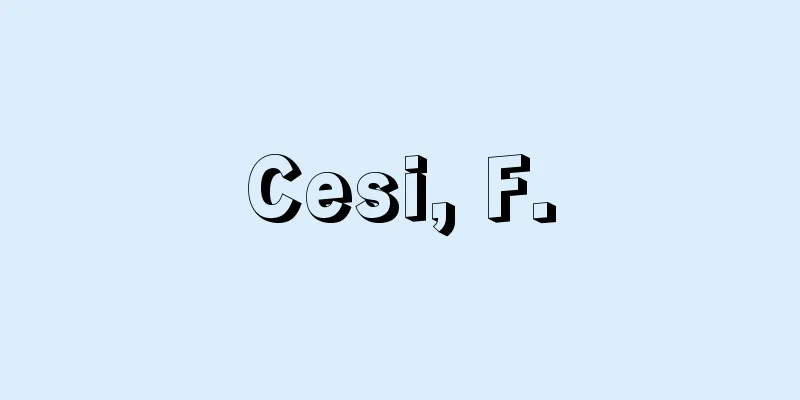Ejaculation - Shasei

|
This refers to the ejaculation of semen. Stimulation of the male genitals gradually excites the ejaculatory center, which then reflexively transmits the stimulation to the vas deferens, and the sperm that are stagnant in the tail of the epididymis are carried to the ampulla of the vas deferens by the peristaltic movement of the vas deferens. When central excitement reaches its peak (orgasm), prostatic fluid, fluid in the ampulla of the vas deferens, and fluid from the seminal vesicles are discharged into the prostatic urethra. When semen is sent into the prostatic urethra, the internal urethral orifice usually closes, preventing the backflow of semen into the bladder, and at the same time, the bulbar urethra expands to two to three times its normal size. The external urethral sphincter then relaxes, and the semen enters the expanded bulbar urethra and spongy urethra. The semen is ejaculated from the external urethral orifice by rhythmic contractions of the perineal muscles, such as the bulbocavernosus and ischiocavernosus muscles, and the urethral sphincter. This series of ejaculation processes is controlled by the hypogastric nerve, pelvic nerve, and pudendal nerve. If the closing function of the internal urethral orifice is impaired, semen will flow back into the bladder (retrograde ejaculation), resulting in azoospermia and infertility. [Masafumi Shirai] Animal ejaculationIn animals, the discharge of semen by a male is also called ejaculation. In mammals, the ejaculation center is located at the bottom of the spinal cord, and is excited by the addition of sensory stimuli from the erect penis, causing ejaculation reflexively. This is due to a series of rhythmic contractions in the smooth muscles of the reproductive duct walls, as follows: First, contractions begin in the epididymal duct walls, then progress to the walls of the vas deferens and the urethra. In the urethra, the semen mixes with secretions from the prostate, seminal vesicles, and urethral glands, and is expelled from the body by rhythmic contractions of the perineal muscles and urethral sphincter. The time required for ejaculation varies from short in sheep, goats, and cows to long in dogs, and the components of semen can be separated by following the time course, and it is particularly easy to separate in species with long semen. The amount of semen also varies by species, reaching up to 250 milliliters in some pigs, but 12 milliliters in dogs and less than 1 milliliter in rabbits and mice. Even in birds, such as chickens, semen can be collected during artificial insemination, and about 0.1 to 0.9 milliliters of semen can be ejaculated. Among terrestrial invertebrates, there are species in which the male inserts his penis into the female's vagina and sends semen directly into her body, which naturally results in ejaculation, but the detailed mechanism behind this is not yet fully understood. [Yasumi Arai] [Reference] | |Source: Shogakukan Encyclopedia Nipponica About Encyclopedia Nipponica Information | Legend |
|
精液が射出されることをいう。男性性器に加えられた刺激により射精中枢はしだいに興奮し、その刺激は反射的に精管に伝えられ、精巣上体(副睾丸(ふくこうがん))尾部に停滞している精子は精管の蠕動(ぜんどう)運動により精管膨大部へと運ばれる。中枢興奮が最高に達すると(オルガスムス)、前立腺(せん)液、精管膨大部内の液、精嚢(せいのう)液などが前立腺部尿道に排出される。精液が前立腺部尿道に送り出されると内尿道口は通常閉じ、精液の膀胱(ぼうこう)内への逆流を防ぐと同時に球部尿道は普通の2~3倍に膨張する。ついで外尿道括約筋が弛緩(しかん)して精液は膨張した球部尿道と海綿体部尿道に入る。この精液は、球海綿体筋や坐骨(ざこつ)海綿体筋などの会陰(えいん)筋および尿道括約筋などの律動的収縮により外尿道口より射出される。これら一連の射精の過程は下腹神経、骨盤神経、陰部神経によりコントロールされている。内尿道口の閉鎖機能が障害されると、精液は膀胱内へ逆流(逆行性射精)して無精液症となり、不妊の原因になる。 [白井將文] 動物の射精動物の場合も、雄が精液を排出することを射精という。哺乳(ほにゅう)類では、脊髄(せきずい)下部に射精中枢があって、勃起(ぼっき)したペニスからの感覚刺激の加重によって興奮し、反射的に射精がおこるが、その仕組みは生殖輸管壁の平滑筋における次のような一連の律動的収縮による。まず、副睾丸管壁の収縮が始まり、輸精管壁、尿道へと進行する。尿道では前立腺、貯精嚢、尿道腺からの分泌物と混合し、ここから会陰筋、尿道括約筋などの律動的収縮により体外へ排出される。射精に要する時間は、ヒツジ、ヤギ、ウシのように短いものと、イヌのように長いものがあるが、その時間的経過を追って精液の成分を分けることができ、長い種ではとくに分けやすい。精液の量も種によって異なり、ブタのように250ミリリットルにも達するものもあるが、イヌでは12ミリリットル、ウサギやネズミなどでは1ミリリットル以下である。 鳥類でも、ニワトリなどでは人工授精の際に精液を採取することがあり、0.1~0.9ミリリットルぐらいの精液の射出がみられる。陸生無脊椎(むせきつい)動物のなかにも、雄が雌の腟(ちつ)内に陰茎を挿入して、雌の体内に精液を直接送り込む種類があり、その際には当然射精がおこるが、その詳しい機序についてはまだ十分にわかっていない。 [新井康允] [参照項目] | |出典 小学館 日本大百科全書(ニッポニカ)日本大百科全書(ニッポニカ)について 情報 | 凡例 |
Recommend
Kiyonari Naito - Kiyonari Naito
1555-1608 Azuchi-Toyotomi: A samurai from the ear...
Year of the Tree - Kinomatoshi
...The story in the Tale of Yamato is famous, and...
Numagaya - Numagaya
A perennial grass of the grass family (illustratio...
Olduvai culture - Olduvai culture
The world's oldest Paleolithic culture is loca...
Aliénor d'Aquitaine
1122?-1204 She was the wife of Louis VII of France...
Chorakuji Temple
[1] A Tendai sect temple in Ota City, Gunma Prefec...
Kuramisou - Kuramisou
A manor in Mikata County, Wakasa Province. It was ...
Titus Flavius Vespasianus
Roman Emperor (reigned 79-81). He was the eldest ...
Japanese Tama Edition - Wagokuhen
A Chinese-Japanese dictionary with character shap...
Pittendrigh, GS (English spelling) PittendrighGS
…However, the results of low-temperature treatmen...
Arranger
〘Name〙 (arranger) Arranger. Source: The Selected E...
Azuma Mai
〘Noun〙 = Azuma Asobi (Eastern Travel) ※Sandai Jits...
sheik
While he played minor roles such as exotic dancer...
Abutilon - Abutilon
A shrub or herb of the Malvaceae family (APG clas...
A row of stamps - Kahan no Retsu
...They were also called Toshiyori, Shukuro, Kaku...









